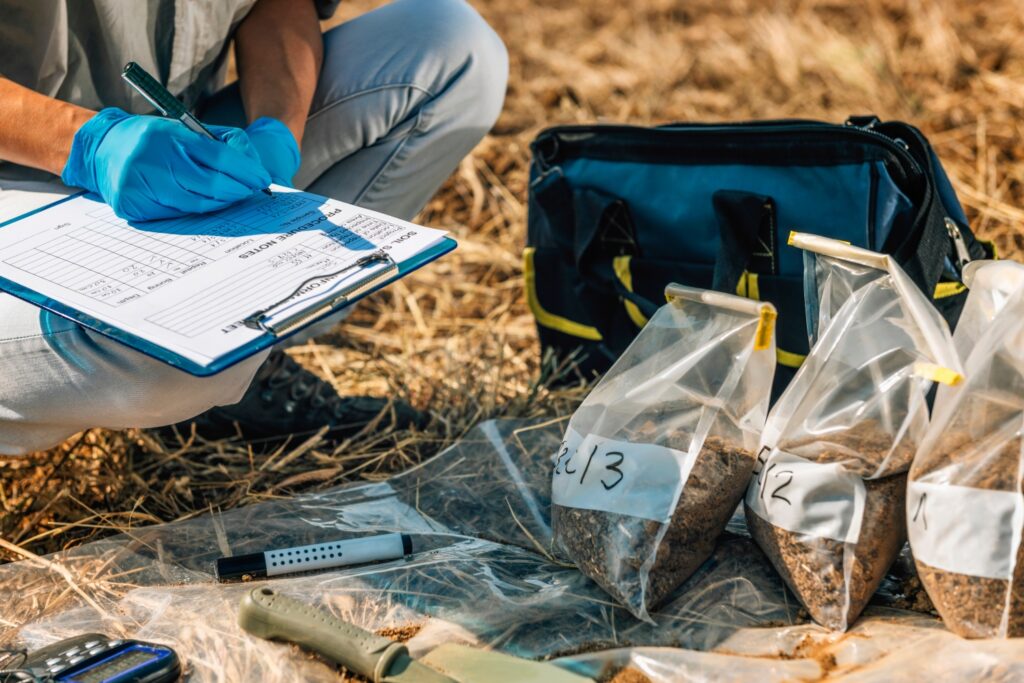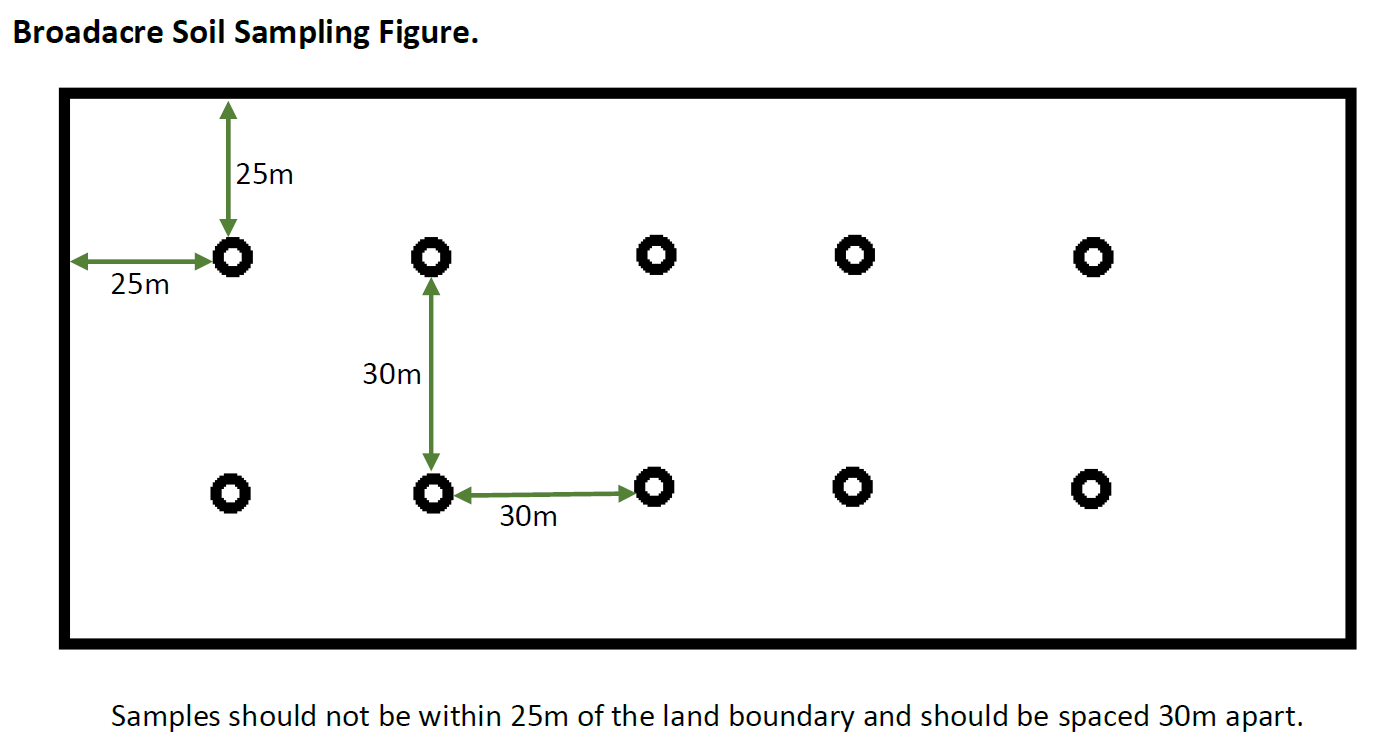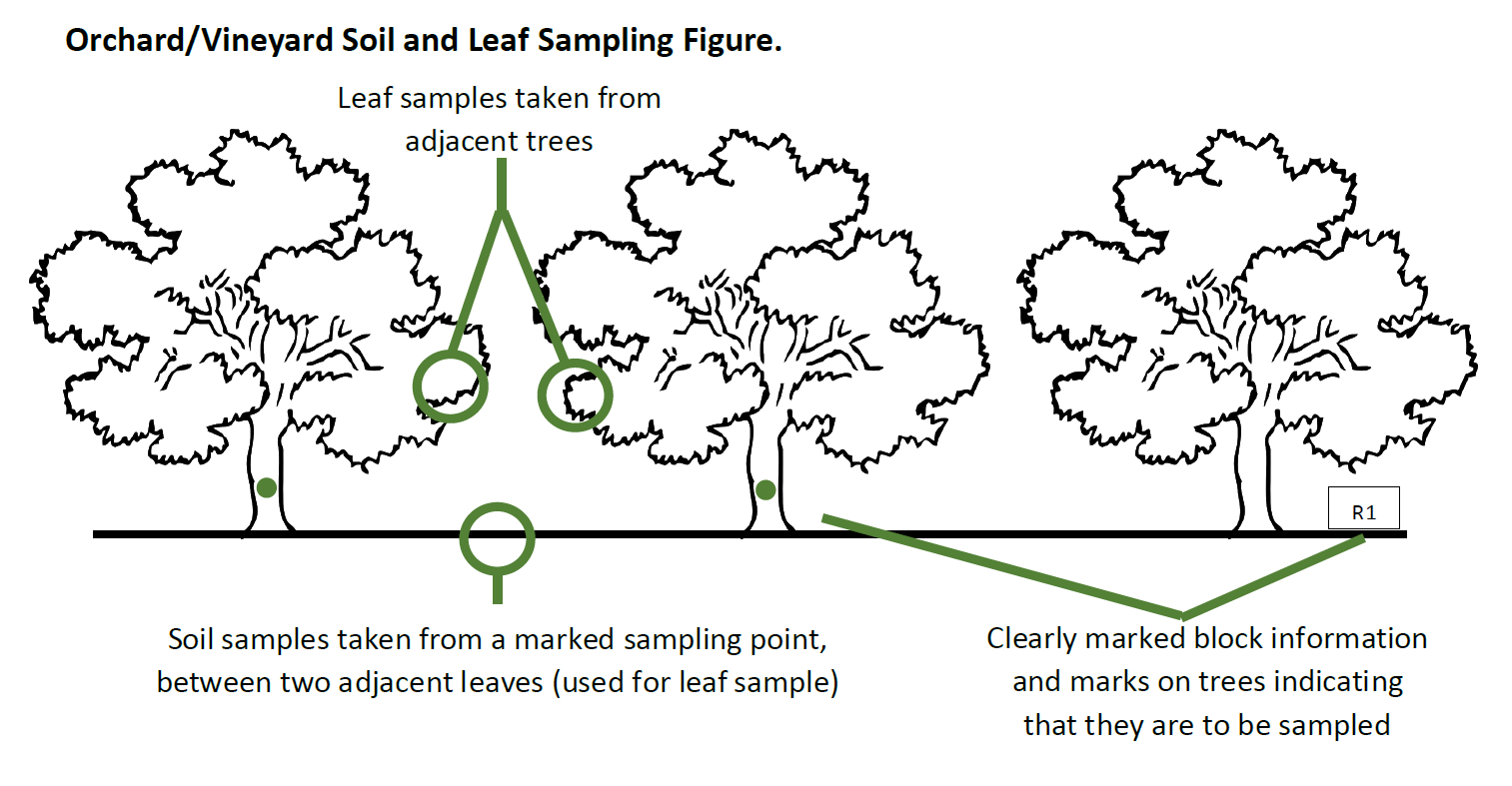
Soil and Leaf Sampling Protocols
Author: Kent Yeatman
Read Time: 5 minutes
1 August 2025
Broadacre Crops (Potatoes, Maize, Wheat, etc.)
- Try not to exceed a composite sample that represents no more than 5Ha.
- Composite samples should be collected in 30m by 30m intervals (9 cores per Ha multiplied by 5Ha, therefore 45 cores blended for 5Ha).
- Divide the field into different homogenous units based on the visual observation and farmers experience.
- Avoid roads, high trample areas by livestock, dung and urine patches, lime dump sites, contours, waterlogged areas and sample at least 25m in from land boarders.
- Please do not change land names or numbers as this creates confusion when sampling in the future or when comparing samples of previous years.
- Soil samples should be taken around the same time each year. An adequate lead-time should be allowed for sample analysis, data interpretation, fertilizer recommendation and actual application.
Soil Sampling Technique
- Remove the top 1cm of soil from sampling point (preferably using a small spade, try to remove all surface organic matter from the sampling point).
- Using a soil auger, sample to a depth of 15cm (if using a beta soil auger, soil will be collected in a bag on the auger. Alternatively place the collected soil into a 5Kg bucket).
- Once all the core samples have been collected, mix the soil thoroughly with a stick to break apart any “clumps” (avoid using hands to prevent contamination).
- Place between 500g – 750g of soil into a clearly labeled soil sample bag (Farm name, land number, crop to be grown).
- When submitting forms to the laboratory, copy in your advisor on land size, land names, farm name, previous crop, indicate soil sample depth (15cm), crop to be grown, dry land or irrigated, as well as target yield.
Soil Analysis Request
For an accurate analysis the following is required:
▪ Bulk density (BD)
▪ Carbon % (C%)
▪ Soil type
▪ pH (KCl)
▪ Electrical Conductivity in ohms (EC)
▪ Titratable acidity (H+)
▪ Stone fraction (Stone %)
▪ Phosphorus (Bray I and Bray II)
▪ Na, K, Ca, Mg, Cu, Zn, Mn, Fe, B, S
Orchards/Vineyards
- Clearly mark block number, block size, number of trees or vines per Ha, row spacing, spacing distance between vines or trees and age of orchard or vineyard on a board.
- Please do not change land names or numbers as this creates confusion when sampling in the future or when comparing samples of previous years.
- Divide the field into different homogenous units based on the visual observation and farmers experience.
- Identify and clearly mark rows from which soil samples and leaf samples will be collected (either by placing a board or painting a stem or pole).
- Clearly mark either two vines or trees adjacent to each other.
- On a map clearly indicate all the information mentioned in point one and mark the sampling points. This will help for planning the sampling technique and for future reference.
- Collect 9 cores per Ha and try not to exceed an area greater than 5Ha.
- Avoid roads, high trample areas by livestock, dung and urine patches, lime dump sites, contours, waterlogged areas and sample at least 25m in from land boarders.
- Soil samples should be taken around the same time each year. An adequate lead-time should be allowed for sample analysis, data interpretation, fertilizer recommendation and actual application.
- When collecting samples in the vineyard/orchard, try not to place samples into/onto any metal surface, as this may contaminate the sample (galvanized steel and rusty steel will give contaminate zinc and iron results respectively).
Soil sampling technique
- Samples to be collected between two clearly marked adjacent trees/vines.
- Remove the top 1cm of soil from sampling point (preferably using a small spade, try to remove all surface organic matter from the sampling point).
- Using a soil auger, sample to a depth of 15cm (if using a beta soil auger, soil will be collected in a bag on the auger. Alternatively place the collected soil into a 5Kg bucket).
- Once all the core samples have been collected, mix the soil thoroughly with a stick (avoid using hands to prevent contamination).
- Place between 500g – 750g of soil into a clearly labeled soil sample bag (Farm name, land number, crop to be grown).
- When submitting forms to the laboratory, copy in your advisor on land size, land names, farm name, previous crop, crop to be grown, dry land or irrigated, as well as target yield.
Leaf Sampling Technique
- Use the same marked soil sampling points and collect leaves from the two adjacent trees.
- Depending on the vine/tree the sampling date and part of plant to be tested varies. For more information on when to collect samples and plant parts to be collected, please contact kent@oasis-agri.co.za
- Sample should be collected from a minimum of 10 plants, usually a minimum of 5 – 10 leaves per plant (minimum sample size 50 leaves).
- When collecting samples in the vineyard/orchard, try not to place samples into/onto any metal surface, as this may contaminate the sample.
- On the sample collection bag indicate farm name, land number, crop and/or variety, stage of growth, soil type if known, irrigation or not, any notes on visual appearance or diseases and pests. The sample bag should be a clear paper bag and not a plastic bag as a plastic bag may tend to develop mold.
- Try not to combine healthy leaves with those showing definite problems (disease, insects, weather or mechanical injury), leaf samples from different varieties, ages and irrigation should not be mixed. As with soil samples, don’t take leaf samples from the boarders of the land.
- To remove the leaf, pull downwards so that the petiole remains attached to the leaf.
- Store leaf samples in a cool environment while taking samples throughout the day and before sending to the laboratory (cooler box, fridge). Samples should be sent to the laboratory immediately or a one-day delivery service should be used, if this is not possible, the samples should be refrigerated until they can be sent.
Leaf Analysis Request
For an accurate analysis the following is required:
▪ N%, P%, K%, Ca%, Mg%, S%
▪ Na, Cu, Zn, Mn, Fe, B and Mo in mg/kg


